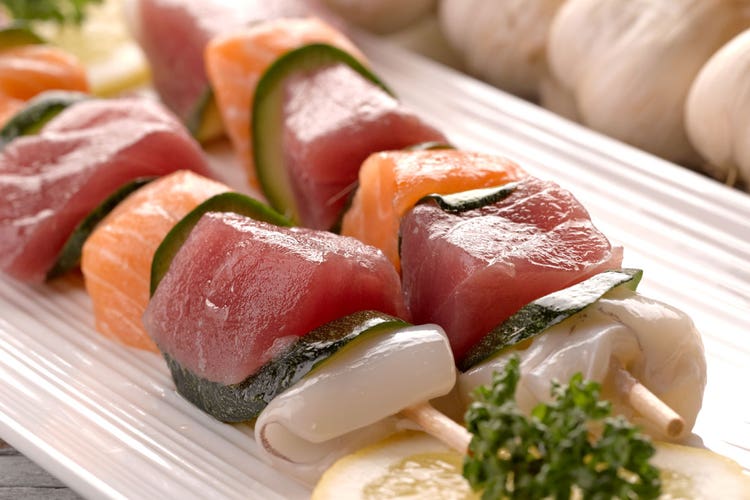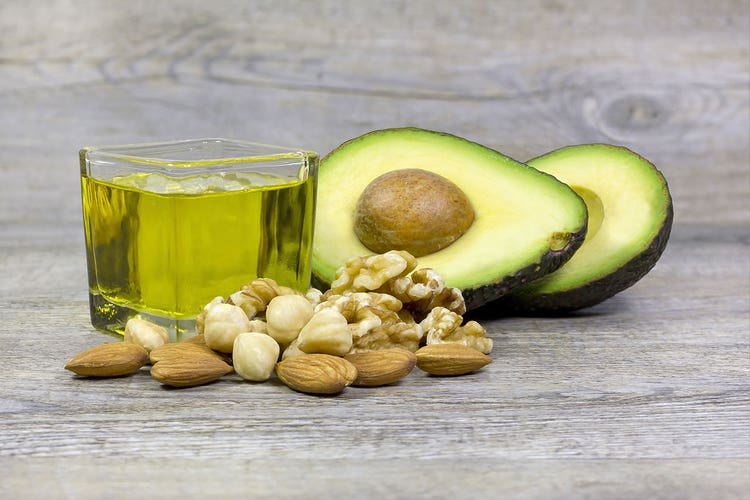Big Fat Diet

Though it sounds like a distant planet or a term from high-school chemistry, the keto (ketogenic) diet is relatively simple. Invented about 100 years ago to reduce seizures in children, the recently repopularized regimen is similar to South Beach and Atkins.
Basically, by consuming a lot of fat, a moderate amount of protein and very few carbohydrates, you coax your body into a metabolic state called ketosis. In ketosis, your body burns dietary fat (fat taken in through food) and fat cells (stored fat) for energy first. In contrast, on the Standard American Diet or another eating plan high in carbs, your body would initially turn to glucose or sugar, delaying the burning of body fat.
Not only does the high intake of fat lead to the burning (reduction) of fat cells, but it also suppresses appetite, decreasing food cravings, attests Suzanne Ryan, who lost 120 pounds on the keto diet and wrote “Simply Keto: A Practical Approach to Health & Weight Loss With 100+ Easy Low-Carb Recipes” (Victory Belt, 2017). The end result? More rapid weight loss. When the body burns fat, breaking it down into fatty acids for usage by the body (a process known as lipolysis), it releases ketones (acidic organic compounds), hence the diet’s name: ketogenic.
If the idea of lots of fat is giving you pause, take a moment to reconsider this essential nutrient. We cannot make fat on our own and need fat to dissolve some vitamins and minerals, explains Leanne Vogel, author of “The Keto Diet: The Complete Guide to a High-Fat Diet” (Victory Belt, 2017). “Fat makes up the outer layer of every cell in your body. …Our muscles need fat, our brains need fat, we just can’t function without it,” she explains. Vogel points out that our hormones are extremely dependent on fat, and insufficient amounts can lead to “imbalances that disrupt the whole body,” for instance impacting menstrual cycles. Replacing fat with carbohydrates and not consuming enough fat, she continues, can lead to “endless raging cravings for sugar.”
Maria and Craig Emmerich, authors of “Keto: The Complete Guide to Success on the Keto Diet, Including Simplified Science and No-Cook Meal Plans” (Victory Belt, 2018), add that saturated fat creates strong cell membranes, helps build strong bones, protects the liver against alcohol and other toxins, improves the immune system and protects the digestive tract. Meanwhile, cholesterol (present in many keto staple foods), they explain, creates strong cell membranes, improves serotonin levels, boosts critical hormones, allows the body to use vitamin D, creates bile, acts as an antioxidant and helps maintain intestinal health.
Avocados, coconut and butter – oh my

Physiology aside, what does the keto diet look like in practice? Strict devotees balance the ratio of macronutrients (protein, fat and carbs) in their diet. They also avoid starches (including grains and vegetables, such as carrots) and sugar (including fruit), which, as Ryan explains, “spike blood sugar and lead to cravings.” Alcohol is also generally avoided because—if present—the body will burn it before sugar and fat. Meanwhile, dietary mainstays include saturated and monounsaturated fats (tallow, lard, duck fat, butter and ghee and oils like olive, coconut and avocado), green vegetables (especially cruciferous varieties), avocado, meat, olives and dairy products.
In a typical day, someone on the keto diet might consume “bulletproof” coffee with MCT oil (manufactured saturated fatty acid, consisting of coconut and palm oils) or heavy cream, a bacon omelet cooked in avocado oil, roasted pork rinds and a steak with broccoli. To determine whether his or her body is in a fat-adapted state (ketosis), the person might measure his or her ketones.
If you’re concerned that you’re not sufficiently disciplined or meat loving to go keto, know that different adherents practice the diet in different ways. For instance, some completely avoid legumes and dairy. Even though carbohydrates are generally verboten, a portion of keto enthusiasts include small amounts. (Vogel calls hers “carb-ups.”) Vegans can follow the diet, too, sourcing fat and protein from nuts, seeds, oils, coconut and avocado. Protein is another variable. Since the body can only store a certain amount and can convert it into glucose or sugar (in a process called gluconeogenesis), certain keto followers limit their protein intake.
As an example of one take on keto, Vogel uses a “low-carb, high-fat Paleo approach,” with occasional carbohydrates to “keep her hormones balanced.” She relies on grass-fed and grass-finished meats (from ButcherBox), lots of low-glycemic vegetables (such as Brussels sprouts, kale, cabbage and cauliflower) and “healthy” fats, including oils (avocado, coconut and olive) and tallow.
Convinced yet? Before you get on the keto bandwagon, know that sticking to the diet can be a challenge. Thanks to the high amount of fat, you shouldn’t feel like you’re starving. Still, you need to be prepared to severely limit your carbs, which can be a sacrifice pleasurewise. Imagine no more sweetened lattes or a daily square of chocolate.
Doctors’ reactions to keto

Further, doctors are mixed on keto. David L. Katz, M.D., director of the Yale-Griffin Prevention Research Center and founder of True Health Initiative, acknowledges that the diet is effective for short-term weight loss and that it might make sense as a temporary way to “reboot one’s approach to controlling weight or health.” He also agrees that “a high-protein diet of this ilk might be helpful for those struggling with appetite control, especially if they take an ‘eco-Atkins’-type approach (i.e., a high-protein, plant-based diet).” Still, he ultimately believes that keto is difficult to sustain and is taxing on the environment. He also worries that the long-term effects on human health are not clear.
Meanwhile, Mark Hyman, M.D., author of “The Eat Fat, Get Thin Cookbook: More Than 175 Delicious Recipes for Sustained Weight Loss and Vibrant Health” (Little, Brown and Co., 2016), is a bit more encouraging. He believes that keto “can be a key tool in the treatment process” for patients with epilepsy, cognitive decline or autism, or helpful for those with pre-diabetes or difficulty losing weight.
That said, Hyman does not recommend it for pregnant women, and he cautions those with adrenal dysfunction or hormonal imbalances to tread carefully. He also doesn’t practice keto himself because he believes that he would lose too much weight if he avoided healthy carbs (such as squash). “This diet can be safe and effective, but you should do it under the supervision of a nutritionist or your doctor,” Hyman advises.
If you’d like to try keto, Vogel suggests experimenting with what she calls “the breakfast test.” It entails trying two breakfasts: one carb-heavy and low-fat (such as a fruit smoothie with protein powder) and the other high-fat and low-carb (such as bacon and eggs with greens). See how you feel after each meal. In particular, note the effects the foods have on your mood and energy level.
For a taste of keto meals, whip up Vogel’s Cajun pork belly chopped salad and Ryan’s bacon-wrapped cheesy chicken below.
RECIPES:
Cajun Pork Belly Chopped Salad
Makes: 4 servings
I’m a sucker for crispy pork skin, and this recipe has the crispiest layer you’ll find in just about any dish. The top is one large cracklin, the inside is juicy and the whole darn thing is full of Cajun flavor. Topped with a cooling salad, there’s nothing I’d change about this recipe. Nothing.
Pork:
- 1 pound side pork belly
- 1 tablespoon refined avocado oil
- 1½ tablespoons Cajun seasoning
Salad:
- 2 cups sliced radishes
- 3 green onions, sliced
- 1 bunch fresh cilantro (about 1¾ ounces), chopped
- ¼ cup chopped fresh mint
- 1 large zucchini (about 10½ ounces), diced
- ¼ cup refined avocado oil or extra-virgin olive oil
- Juice of 2 limes
- ¼ teaspoon finely ground gray sea salt
- 2 drops liquid stevia
- Remove the pork belly from its packaging and place it fat side up on a cutting board. Using a sharp knife, score the top with diagonal lines about ½ inch apart. Drizzle the entire pork belly with the avocado oil, and top with the Cajun seasoning. Rub thoroughly. Wrap in plastic wrap and set in the fridge for at least 2 hours and up to 24 hours.
- When ready to cook the pork belly, preheat the oven to 500°F and place the pork belly, fat side up, in a cast-iron or other broiler-safe pan. Cook for 15 minutes, until browned. Reduce the oven temperature to 325°F and continue cooking for 1½ hours, or until the top and sides are dark brown and the internal temperature reaches 165°F. Remove the pork belly from the oven and set it on a cutting board; allow to rest for 5 minutes.
- Meanwhile, prepare the salad: Place all the ingredients in a large bowl. Toss to combine, then spread out the salad on a large serving platter. Using a sharp knife, slice the pork belly, then arrange the slices on top of the salad. Serve with lime wedges on the side, if desired.
*Adapted from of “The Keto Diet: The Complete Guide to a High-Fat Diet” by Leanne Vogel (Victory Belt, 2017).
Bacon-Wrapped Cheesy Chicken
Makes: 4 servings
- 2 boneless, skinless chicken breast halves (about 1½ pounds)
- Salt and pepper
- 2 tablespoons ranch dressing, plus extra for serving
- 1 cup white mushrooms, sliced
- ¾ cup shredded cheddar cheese
- 8 slices thin-sliced or regular bacon, cut in half crosswise
- Chopped fresh parsley, for garnish (optional)
- Preheat the oven to 375°F. Line a shallow baking pan with parchment paper. Cut each chicken breast in half horizontally to make four fillets that are about ½ inch thick at the wider end. Season the chicken with salt and pepper.
- Place the chicken in a bowl and top with the dressing; toss to coat. Place the coated chicken fillets in the lined baking pan, spaced 1 inch apart. Top each fillet with ¼ cup of the mushrooms, then sprinkle 3 tablespoons of the cheddar cheese on top of the mushrooms.
- Drape each chicken stack with 4 half-slices of bacon, fully covering the surface of the chicken. Bake for 25 to 30 minutes, until the internal temperature of the chicken reaches 165°F, then set the oven to broil for five minutes to crisp the bacon. Garnish with parsley before serving, if desired. Serve with ranch.
*Adapted from “Simply Keto: A Practical Approach to Health & Weight Loss With 100+ Easy Low-Carb Recipes” by Suzanne Ryan(Victory Belt, 2017).
Photo credit: Marco Mayer, Adobe Stock; Photo Art Lucas, Adobe Stock; rocketclips, Adobe Stock